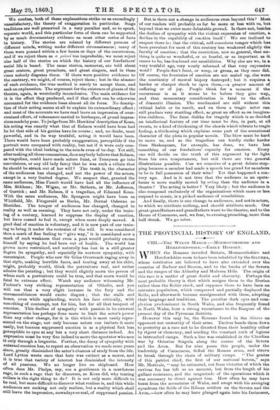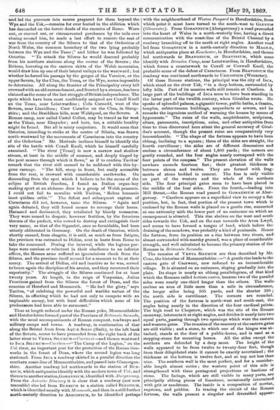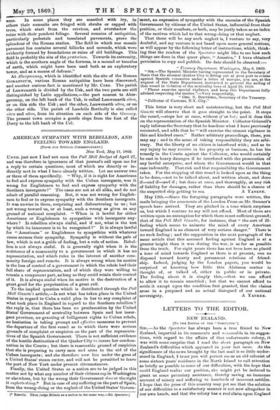THE PROVINCIAL HISTORY OF ENGLAND. • cia.—THE WELSH MARCH :—MONMOUTUSUIRE AND HEREFORDSHIRE. —EARLY llisxonv.
WHEN the Romans invaded Britain, Monmouthshire and Herefordshire seem to have been inhabited by the SILURES, whose territories are believed to have also extended over the counties of Radnor and Brecon, and to the banks of the Severn and the ranges of the Abberley and Malvern Hills. The origin of this race is a matter of great doubt and obscurity. Perhaps the most probable theory is that which assigns them to the Iberian rather than the Keltic stock, and supposes them to have been an intrusive population, which conquered and partially displaced the Kelts, and afterwards became amalgamated with them, adopting their language and traditions. The peculiar dark eyes and complexion predominant in South Wales, and also frequently found in North Wales, bear a strong resembance to the Basques of the present day of the Pyrenean districts.
However this may be, the Romans found in the Silures an opponent not unworthy of their arms. Tacitus hands them down to posterity as a race not to be diverted from their hostility either by rigour or clemency, and needing the constant curb of legions in intrenched camps. Such a line was established in the Claudian war by Oatorius Scapula along the course of the Severn and the Avon. But for nine years this people, under the leadership of Caractacus, defied the Roman arms, and strove to break through the chain of military camps. " The genius of this patriot chief, the first of our national heroes," says Mr. Merivale, " may be estimated, not from victories of which the envious foe has left us no account, but from the length of his gallant resistance, and the magnitude of the operations which it was necessary to direct against him. How often he may have burst from the mountains of Wales, and swept with his avenging squadrons the fields of the Masan settlers on the Severn and the Avon,—how often he may have plunged again into his fastnesses,
and led the pursuers into snares prepared for them beyond the Wye and the Usk,—remains for ever buried in the oblivion which has descended on the heroic deeds of the enemies of Rome. Worn out, or starved oat, or circumvented perchance by the toils ever closing around him, he made a last effort to remove the seat of war from the country of the Silures to that of the Ordovices of North Wales, the common boundary of the two lying probably between the Wye and the Teme ;" and hither he was followed by Ostorius. " To attack the Silures he would descend probably from his northern stations along the course of the Severn ; the Britons, hovering on the eastern skirts of the Welsh mountains, would draw him up one of their lateral valleys to the westward ; but whether he forced his passage by the gorges of the Verniew, or the upper Severn, by the Clun, the Temp, or the Wye, seems impossible to determine. All along the frontier of the Principality every hill crowned with an old entrenchment, and fronted by a stream, has been claimed as the scene of the last struggle of British independence. The spots which have been most confidently assigned are Coxall Knoll on the Teme, near Leintwardine ; Cefn Carnedd, west of the Severn, near Llaniclloes ; Caer Caradoc on the Clun, in Shropshire ; and the Breiddhen hills, near Welshpool, on the Severn. A Roman camp, now called Castel Celle°, may be traced as far west as the Ythan, near Rhayader ; and here, too, a suitable locality might be found. But all is misty conjecture. It would seem that Ostorius, intending to strike at the centre of Siluria, was drawn north-westward by the movements of Caractacus into the country of the Ordovices." Mr. Merivale inclines himself to identify the site of the battle with Coxall Knoll, which he himself carefully examined. "The river [Tenn] is now a narrow and shallow stream, at least in the middle of summer, and deeply tinged by the peat mosses through which it flows," as if to confirm Tacit us' remark that the river still seemed to be reddened with this bygone carnage. "The hill, steep in front, but easily accessible from the rear, is crowned with considerable earthworks. On descending from the spot which I believe to be the scene of the eclipse of British freedom, I found an Italian organ-boy making sport at an alehouse door to a group of Welsh peasants. I could not fail to moralize with Tacitus, Rebus humanis inest quidam orbis.' " The defeat and subsequent capture of Caractacus did not, however, tame the Silures. " Again and again defeated, they still found means to revenge their loses. Harassed and decimated, they retaliated by bloody massacres. They were roused to despair, however fruitless, by the ferocious threats of the prefect, who vowed to destroy and extinguish their very name, as that of the Sigambri, once so formidable, had been utterly obliterated in Germany. On the death of Oatorius, which shortly ensued, from chagrin, it is said, as much as from fatigue, the province was entrusted to Didius, sent in haste from Rome to take the command. During the interval, while the legions perhaps were careless or reluctant in their obedience to an inferior officer, the Roman arms suffered an ignominious check from the Silures, and the province itself seemed for a moment to lie at their mercy. The arrival of Didius, old and inactive as he was, served to brace again the discipline of his armies, and they recovered their superiority." The struggle of the Silures continued for at least twenty years. At length, in the reign of Vespasian, Julius Frontinus gained from the Silures the forest of Dean, and the counties of Hereford and Monmouth. " He had the glory," says Tacitus, "of subduing the powerful and warlike nation of the Silures, in effecting which he had not only to compete with an implacable enemy, but with local difficulties which none of his predecessors had been able to surmount."
Thus at length reduced under the Roman yoke, Monmouthahire and Herefordshire formed partof the Province of Britannia Secunda, with the usual accompaniments of Roman conquest, roadways and military camps and towns. A roadway, in continuation of that along the Bristol Avon from Aquas Sous (Bath), to the left bank of the Severn, seems to have proceeded from the right batik of the latter river to YENTA SILURUM —Caencent —and thence westward to IscA SILURUM—Caerleon—" The Camp of the Legion," on the Usk river, an important post for the protection of the Roman ironworks in the forest of Dean, where the second legion was long stationed. From IscA a roadway skirted in a parallel direction the southern coast-line of Monmouthshire, and passed into Glamorganshire. Another roadway led northwards to the station of BURmum, which antiquaries identify with the modern town of Usk, and thence to another station,GonAssrum, identified with Abe rgacenny. From the Antonine Itinerary it is clear that a roadway (not now traceable) also led from BURRIUM to a station called BLESTIUM, which is identified usually with Monmouth, and then in a still further north-easterly direction to Anicostum, to be identified perhaps with the neighbourhood of Weston Penyard in Herefordshire, from which point it must have turned to the south-west to GLEvresc (Gloucester). From GOBANNIUM (Abergavenny) a road proceeded into the heart of Wales in a north-westerly line, having a direct communication with the coast-line of the Bristol Channel by a roadway branching off to the south at right angles. Another road led from Gonaansaum in a north-easterly direction to MAGN/E, which antiquaries place at Kenchester, in Herefordshire, and thence led northwards to BnAvosium, or BRAVINIUM, which some identify with Brandon Camp, near Leintwardine, in Herefordshire, which forms a counterwork to Cozen or Coswall Knoll, the probable scene of the defeat of Caractacus. From BaAvosrom the roadway was continued northwards to URICONIUM (Wroxeter).
Of these Roman stations, the principal was the city of Isca, which stood on the river Usk, "in a deep bottom, surrounded by lofty hills. Part of its massive walls still remain at Caerleon. A large part of the buildings of IscA seem to have been standing in the latter part of the twelfth century, when Giraldus wrote. He speaks of splendid palaces, a gigantic tower, public baths, a theatre, temples, subterranean buildings, acqueducts or sewers, and he remarks the ingenious method of warming the houses by means of hypocausts." The ruins of the walls, amphitheatre, sculptures, altars, pavements, inscriptions, coins, and other antiquities from time to time discovered here attest the general accuracy of Giraldua's account, though the present ruins are comparatively very inconsiderable. " The shape of the fortress appears to have been oblong, inclining to a square ; three of the sides are straight, the fourth curvilinear ; the sides are of different dimensions and enclose a circumference of about 1,800 yards ; the corners are gently rounded, and the four angles nearly correspond with the four points of the compass." The present elevation of the walls nowhere exceeds fourteen feet ; their greatest thickness is between eleven and twelve. They are formed with fragments of stone bedded in cement. The foss is only visible on part of the western and the whole of the northern side. The four principal gates seem to have been placed in the middle of the four sides. From the fourth,—leading into Mill Street,—the Roman road passed to GOBANNIUM or Abergaveny. " Caerleon appears on a superficial view to occupy a flatposition, but, in fact, that portion of the present town which is enclosed by the Roman walls is placed on a gentle rise, connected at one extremity with the lower part of an eminence on which an encampment is situated. This rise shelves on the west and south sides towards the Usk, and on the east towards the Avon Lwyd, and seems to have formed a tongue of land, which before the• draining of the meadows, was probably a kind of peninsula. Hence• the fortress, from its position on a rise between two rivers, and' almost surrounded with marshy ground, was a place of considerable strength, and well calculated to become the primary station of the Romans in Britannia Secunda.
The remains of YENTA SILURUM are thus described by Mr. Coxe, the historian of Monmouthshire :—" A gentle rise leads to the eastern gate of Caerwent, now reduced to an inconsiderable village. It is situated on an eminence, sloping gradually into the plain. Its shape is nearly an oblong parallelogram, of that kind which the Romans called tertiata castra, because two of the parallel sides were nearly one-third longer than the others. The walla enclose an area of little more than a mile in circumference, the longer sides being 505 yards, and the shorter 390 ; the north side is curvilinear. The corners are rounded. The position of the fortress is north-west and south-east, the angles being nearly in the direction of the four cardinal points.. The high road to Chepstow, which was the site of the Roman causeway, intersects it at right angles, and divides it nearly into two• equal parts,-passing through two openings which were the eastern and western gates. The remains of the masonry at the eastern gates are still visible ; and a stone, to which one of the hinges was attached, stands at the door of a public-house, and is used as a stepping-stone for mounting horses. All the aides except the southern are defended by a deep moat. The height of the walls appeared to be from twelve to twenty-four feet, though from their dilapidated state it cannot be exactly ascertained ; the thickness at the bottom is twelve feet, and at top not less than nine. The southern wall is the most perfect, and for a considerable length almost entire ; the western point of this side is strengthened with three pentagonal projections or bastions of stone. The facings, which are still visible in many parts, are principally oblong pieces of limestone, occasionally intermixed with grit or sandstone. The inside is a composition of mortar, ragatone, and pebbles. In tracing the circuit of the Roman fortress, the walls present a singular and diversified appear ance. In some places they are mantled with ivy, in others their summits are fringed with shrubs or capped with trees, Which start from the crevices, and overshadow the ruins with their pendent foliage. Several remains of antiquities, particularly pedestals and tesselated pavements, prove the splendour of the Roman station. The field in which one mosaic pavement lies contains several hillocks and mounds, which were evidently formed by foundations or ruins of old buildings. This field is probably the site of the prtetorium. Towards its extremity, which is the southern angle of the fortress, is a mound or tumulus of earth, which might have been used both as an exploratory tower, and as a means of defence."
At Abergavenny, which is identified with the site of the Roman GOBANNIUM, various Roman antiquities have been discovered, and another curious fact is mentioned by Mr. Coxe. The parish of Lanwenarth is divided by the Usk, and the two parts are still distinguished by Latin appellations,—the part nearest to Abergavenny, on the left bank of the Usk, is called Lanwenarth citra, or on this side the Usk ; and the other, Lanwenarth ultra, or on the other side. The parish of Landeilo Bertholly is also called citra and ultra, from its situation on each side of the Gaveney. The present town occupies a gentle slope from the foot of the Derry to the left bank of the Usk.
































 Previous page
Previous page